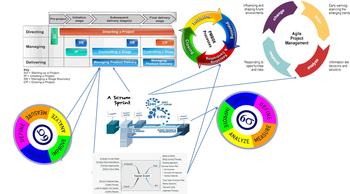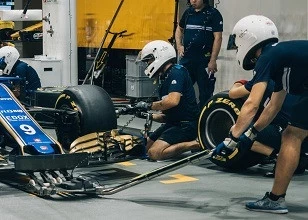Trying to find the right project management methodology? Consider linking different ones together
Add bookmark
We need to break away from the debate of which methodology is the best for which domain, writes contributor Khwaja Moinuddin. Instead, study the different methodologies/tools/principles to find out which elements work best for a particular problem or initiative. Here's a primer....
There are various project management methodologies such as PMP, Prince2, Lean, Lean Six Sigma (DMAIC), Agile etc. They are depicted in the figure below. Detailed toolkits of each methodology/framework can be found in the appendix.
All Project Management methodologies are aimed at one thing and that is to add value to the business with minimum risk. We tend to categorize or believe that only certain methodologies work for certain domains and that is not completely true. For example, we may tend to think Agile is only applicable for software projects, whereas it can be used for lean six sigma projects as well, regardless of the domain.
We need to break away from the debate of which methodology is the best (for which domain) and instead study the different methodologies/tools/principles etc, applying which elements work best for a particular problem or initiative.
All the methodologies equip us with a set of tools. The more the methodologies we know, the more the tools we have in our toolkit. This in turn would enable a practitioner to use any tool regardless of which discipline it comes from.
This article outlines the similarities and potential linkages between some of the methodologies at a high level so that a project can deliver the best output (and outcome).
A large project, for example a building project, is in fact made up of many smaller projects, managed by different teams. In our example the blueprints, foundations, block work, electrical systems, plumbing etc. would likely be overseen by different project teams so that, while the overall goal is large in scope, the smaller pieces of the puzzle are managed in an effective and efficient manner to minimize risk. We call this kind of project a Program or Mega Project. Typically a Governance structure is set-up (a project management team for example) to oversee the Program.
Before a project (or an initiative) is started, a certain amount of ‘planning’ or ‘initiating’ is required. Every project management methodology has an initiating/planning phase which could be a Define phase (in Lean Six Sigma - DMAIC), Planning phase (in PMP), SU/IP (in Prince2), Sprint planning (in Agile software development) etc.
The ‘planning’ depth, effort/timeline and documentation vary as per the prescribed project management methodology (and of course the type of project) and involves understanding the customers’ pain areas or project/product requirements by collecting Voice of the Customer ([VOC] or Client, Business, Stakeholders etc.). Understand the VOC and translate it into measurable end requirements and features, improvements or products etc. that need to be delivered as an output of the completed project within a defined timeline.
Depending on the project management methodology (and the type of project), various governance structures are set-up during this planning phase. They could be pre-set as part of the Mega Project/Program as well. A project team is formed (including Project Leader/Manager, Product Owner, Scrum Master, Development team, Master Black Belt, Black Belt, Process Owner, Champion, Engineering team, Construction team, Production team, Project team etc depending on the type of the project). Teams typically go through the 4 stages - Forming, Storming, Norming and Performing.
Strategy/Communication/Documentation around the project is set-up (for example, PID – Project Initiation Document, Communication Management Strategy, Quality Management Strategy, Risk Management Strategy etc in Prince2, Risk/Cost/Schedule/Scope etc in PMBOK).
Figure: How different methodologies can be potentially linked
An example of how the methodologies complement each other and link with each other is illustrated in the figure above. For example, in the managing product delivery process (in Prince2), a scrum methodology can be applied to deliver products incrementally or a kaizen event can be used (for a manufacturing/service process) to deliver improvements rapidly.
Every project management methodology recommends or involves some form of change management methodology to ensure that the human aspect of project management is addressed. It could be the GE’s CAP (Change Acceleration Process), Kotter’s 8 step change management model, ADKAR (Awareness, Desire, Knowledge, Ability and Enforcement) model etc. Change Management is done throughout the life of the project (and beyond in some cases). Nowadays, dedicated change management teams are set-up to ensure change (improvement) sustains beyond the project.
To manage a project effectively and efficiently, it is divided into phases/parts. Depending on the methodology, some form of periodic review is conducted towards the end of each phase and a ‘go/no-go’ decision (for the project) is taken. Obstacles/barriers in the project emerge (for example, are captured risk registers, daily logs in Prince2) and plans are developed to mitigate them. One of the principles of Prince2 which could be applied here is "Continued Business Justification" meaning is the project still worth doing?
In DMAIC, at the end of each phase (Define, Measure, Analyze, Improve and Control), a toll gate review is conducted (with the Project Sponsor/Champion, Project Leader and Master Black Belt). In the case of Scrum, this could be the daily scrum meetings of 15 mins where what work was done in the last 24 hours, what will be done in the next 24 hours and what impediments exist are discussed among the Development Team Members, Product Owner and Scrum Master. Sprint review and retrospective is also an example of a review in Scrum that happens to ensure the product increment is being delivered as per plan.
In the next phase(s), depending on the type of project (and the methodology), project outputs are delivered. Measurement, Analysis and Improvement of the current state is done in DMAIC; Success criteria (of project or sprint in the case of software development) are refined and work packages/product increments are delivered. Tools/Phases could be - Measure/Analyze/Improve Phase in DMAIC - Control Charts, Measurement Systems Analysis, Process Capability, Hypothesis tests, Regression, DOE, Directing a Project/Managing Product delivery in Prince2, Executing and Controlling in PMP (PMBOK), Prioritization of product backlog to form a sprint backlog by Product owner Sprint execution and Product increment in Agile (Scrum), etc.
One of the principles of Prince2 which could be applied towards the end of each phase again is "Continued Business Justification" meaning is the project still worth doing? If the project is deemed not worth continuing at any stage/phase, it MUST be brought to a logical closure by the person accountable for the project (Product Owner in the case of Scrum, Champion/Sponsor in the case of DMAIC, and Pre-mature closure by Project Executive in the case of Prince2 etc).
In the next phase, depending on the type of project (and the methodology), formal closure and handover of the project happens. This would be the Control phase in the case of DMAIC, Sprint review or final product review in the case of Agile (Scrum), Closing in the case of PMP (PMBOK), CP (Closing a Project) in the case of Prince2 etc. All documentation is completed with respect to the project output/product, plan vs actual compared and savings calculated, final capability vs. initial capability of the process determined, SOPs updated or developed, etc. Changes in systems and structures (of the organization if applicable) are completed in parallel as well.
Project output or Product is formally signed off by the client or sponsor or business/stakeholder and reward and recognition for the completion of the project (certification, felicitation etc) follows.
A new project (which was already waiting in queue) is kicked off and the cycle continues to develop new products or processes or improve current processes to make our world a better place.
[eventPDF]
References:
- http://store.advisicon.com/products/pmbok-5-process-group-map
- http://www.prince2.com/prince2-processes
- http://hennyportman.wordpress.com/2012/10/27/prince2-in-pictures/
- http://www.siliconbeachtraining.co.uk/blog/lean-six-sigma-for-the-office-and-service-industry
- http://www.ibm.com/developerworks/bpm/bpmjournal/1308_col_schume/1308_schume.html
- http://www.triz-journal.com/content/c110103a.asp
- http://members.questline.com/Article.aspx?articleID=21050&accountID=35&nl=12353
- http://blog.vanharen.net/project-management/scrum-in-3-minutes-2/





























